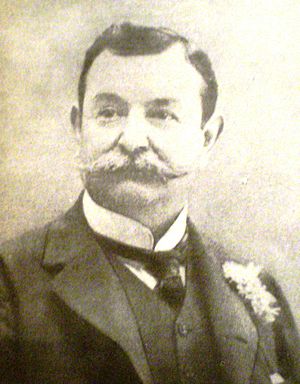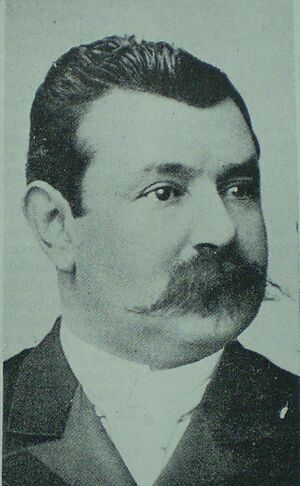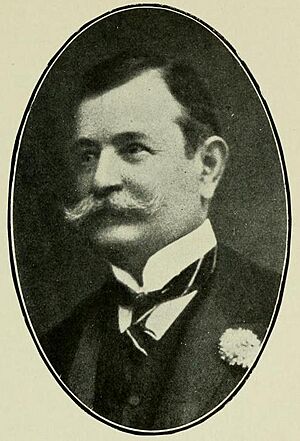Estanislao Zeballos facts for kids
Quick facts for kids
Estanislao Severo Zeballos
|
|
|---|---|

Estanislao S. Zeballos
|
|
| Born | 27 July 1854 Rosario, Santa Fe, Argentina
|
| Died | 4 October 1923 (aged 69) Liverpool, United Kingdom
|
| Nationality | Argentine |
| Occupation | Lawyer, politician, writer |
| Signature | |
Estanislao Severo Zeballos (born July 27, 1854 – died October 4, 1923) was an important Argentine lawyer, politician, and writer. He served as his country's Minister of Foreign Affairs three times. He was known as a very smart and influential person of his era. Zeballos wrote many books and articles about different topics, like history, geography, and culture.
Estanislao Zeballos: A Life of Learning and Leadership
His Early Life and Education
Estanislao Severo Zeballos was born in Rosario, Santa Fe, Argentina, on July 27, 1854. He was the oldest son of Estanislao Zeballos, a military officer, and Felisa Juárez. His parents came from well-known families in Rosario, which helped him later in his career.
When he was young, Zeballos had a scary adventure. He was with his father near Arequito, Santa Fe when they were attacked by a group of Ranquel people. Luckily, they managed to escape quickly.
He first studied at the School of Arts and Crafts in his hometown. Thanks to Governor Nicasio Oroño, Estanislao received a scholarship at age twelve. This allowed him to continue his studies at the National College of Buenos Aires.
Facing Challenges in Buenos Aires
Between 1870 and 1871, yellow fever spread through Buenos Aires. Zeballos helped a doctor named José Camilo Paz move victims' bodies. Zeballos himself got sick but recovered.
He then went on to study law and science at the University of Buenos Aires. He was one of the students who started the "Revolutionary Junta for University Reform." This group wanted to make changes to how the university was run.
In 1874, Zeballos finished his law degree. He immediately started teaching at the National College. That same year, he began working as a reporter for the newspaper La Prensa. He stayed connected to this newspaper for his whole life, eventually becoming its editor.
A Passion for Science and Writing
Zeballos was very interested in science. In 1872, he helped create the "Society of Scientific Stimulus," which later became the "Scientific Society of Argentina." He was a very active member and edited their magazine, Anales. To earn money, he also worked for a German naturalist named Germán Burmeister, who was the director of the Public Museum.
In 1875, he suggested creating a Museum of Natural Sciences. A year before, he had found the bones of a giant sloth near the Parana river. He also wrote a report about an ancient mound in Campana, Buenos Aires. This helped start organized archaeological research in Argentina.
Zeballos supported Francisco Pascasio Moreno's trips to explore the Rio Negro and Río Limay rivers. Later, Zeballos used the information from these trips in his book The Conquest of Fifteen Thousand Leagues (1878). He wrote this book quickly to convince politicians to fund the Conquest of the Desert. This was a military campaign led by General Julio Argentino Roca.
Writing About the Land and People
In his book, Zeballos wrote about the Mapuche people. He suggested they were from Chile and should return there. This idea fit with the plans of leaders like Nicolás Avellaneda and Julio Argentino Roca to expand Argentina's territory. However, it's important to know that the Mapuche people lived in the region long before Chile became a country.
In 1879, Zeballos started the "Argentine Geographic Institute" and became its first president. He also helped Florentino Ameghino get money to publish his studies on ancient mammals.
After Roca's campaign, Zeballos traveled to northern Patagonia in 1879. He wrote about his observations in Journey to the Country of the Araucanians (1881). This was the first part of a series, followed by The Region of Wheat (1883) and Through the Huts (1888). He also wrote stories about famous Mapuche leaders like Calfucurá and Painé.
A Career in Politics
Zeballos became a provincial deputy in 1880. A year later, he was elected as a national deputy. During a political uprising in 1880, he supported President Nicolás Avellaneda.
As a national deputy, Zeballos proposed many new laws. These included laws about trade, farming, railways, and even civil marriage. At age 30, he ran for governor of Santa Fe. He started his own political party, the Constitution Party. However, he didn't get support from President Roca because he supported a different candidate for president. Even so, Zeballos was elected national deputy again in 1886.
Serving as Foreign Minister
In 1889, President Juárez Celman appointed Zeballos as Foreign Minister. At this time, Argentina had border disagreements with Chile. Zeballos created a special team to buy modern weapons in Europe to protect the country. He resigned from this role in 1890 during a political crisis.
Zeballos became Foreign Minister again from 1891 to 1892 under President Carlos Pellegrini. During this time, he refused to pay compensation to British citizens for damages during a revolution. He also dealt with issues with France and signed a trade agreement with them.
He also had different ideas about the border treaty of 1881 with Chile. He played a key role in the "Baltimore Incident," supporting the United States against the Chilean government.
Later, he was appointed as a diplomat to Mexico but was sent to the United States instead. There, he met with President Grover Cleveland to help settle a border dispute with Brazil in Misiones Province.
After this, he left politics for several years. He worked as a private lawyer and taught at the University of Buenos Aires. In 1901, he joined the National Academy of History of Argentina.
Later Years in Diplomacy and Law
In 1905, Zeballos returned to diplomatic matters. He wrote an article about the dispute over the Beagle Channel islands with Chile.
In 1906, President José Figueroa Alcorta appointed him Foreign Minister again. During this time, he worked to prevent war with Brazil. He tried to get more warships for Argentina, which was part of the South American dreadnought race. Some people accused him of wanting war or even planning an attack on Brazil. Others thought he was just doing his job by defending Argentina's borders.
In 1908, he briefly took on other government roles but resigned due to political issues. He then traveled around Argentina, sharing his ideas about foreign policy. He believed that having a strong military was important for peace and fairness in disputes. He wrote:
It causes me much grief, gentlemen, that every day the august name of peace is profaned in Argentina! Peace is life.
He also spoke about the need to improve Argentina's railways and transportation systems. He felt that national interests should be more important than private companies' interests.
Returning to Congress
Zeballos became a national deputy again from 1912 to 1916. During this time, he gave some of his most famous speeches in parliament. He debated with other politicians about important issues.
In 1914, during a discussion about banks, he said:
As regards the protection of foreign capital, the country has abdicated its sovereignty and dignity; its sovereignty because we have placed the supreme power to issue currency in the hands of unknown foreigners ... of our dignity because we do not defend ourselves from exploitation by foreign capital, which has grown to form monopolies, so that a few hands manipulate the wealth of Argentina, imposing the voracious law of prices on large and small, on wheat and bread.
This means he believed that foreign money was too powerful in Argentina and that the country was losing control over its own economy.
His speech defending Argentina's rights after a ship called "President Mitre" was captured by Great Britain in 1915 was so important that it was included in the official records of the United States House of Representatives.
He also worked on projects related to farming, irrigation, and building roads. He wanted to help Argentina's shipping industry grow.
Final Years and Legacy
In 1918, Zeballos became the Dean of the Law Faculty at the University of Buenos Aires. He had taught International Private Law there for 24 years. He developed his own legal theory, which was adopted by the International Law Association in 1922.
At 69, he traveled to the United States. He was invited by Harvard University to give a series of lectures in English. These lectures were published after his death. From the United States, he went to England and passed away in Liverpool on October 4, 1923. His remains are buried in the La Recoleta Cemetery in Buenos Aires.
His Writings
Estanislao Zeballos was a very active writer. He published over 400 books, articles, lectures, and biographies. Some of his well-known works include:
- La conquista de 15.000 leguas (The Conquest of 15,000 Leagues) (1878)
- Viaje al país de los araucanos (Journey to the Country of the Araucanians) (1881)
- Descripción amena de la República Argentina (Pleasant Description of the Argentine Republic) (1881)
- Callvucurá y la dinastía de los piedra (Callvucurá and the Dynasty of the Stone) (1884)
- Painé y la dinastía de los zorros (Painé and the Dynasty of the Foxes) (1886)
- Relmú, reina de los pinares (Relmú, Queen of the Pine Forests) (1888)
- El Escudo y los Colores nacionales (The National Shield and Colors) (1900)
- La Nationalité au point de vue de la législation comparée et du Droit Privé humain (Nationality from the Point of View of Comparative Legislation and Human Private Law), 5 Vols., Paris (1914-1919).
He also wrote biographies of important figures like Barón del Río Branco, Bartolomé Mitre, Julio Argentino Roca, and Domingo Faustino Sarmiento. He had many unpublished works, including an unfinished history of the War with Paraguay.
See also
 In Spanish: Estanislao Zeballos para niños
In Spanish: Estanislao Zeballos para niños



